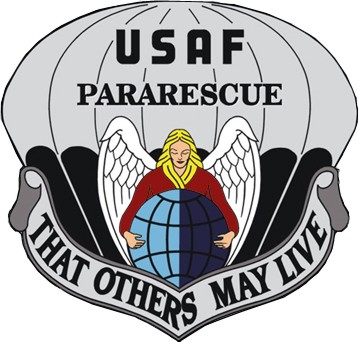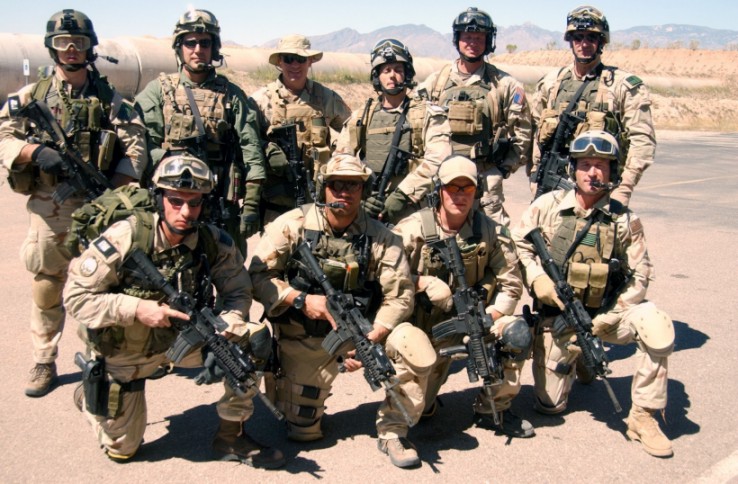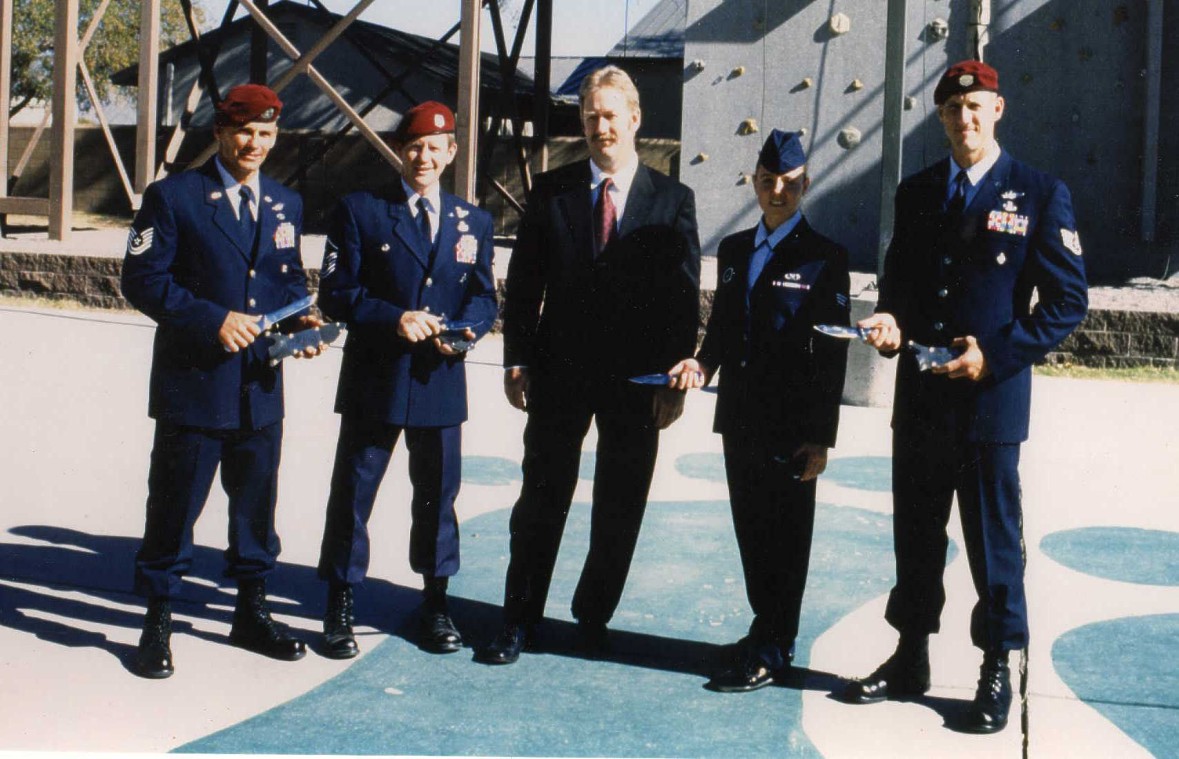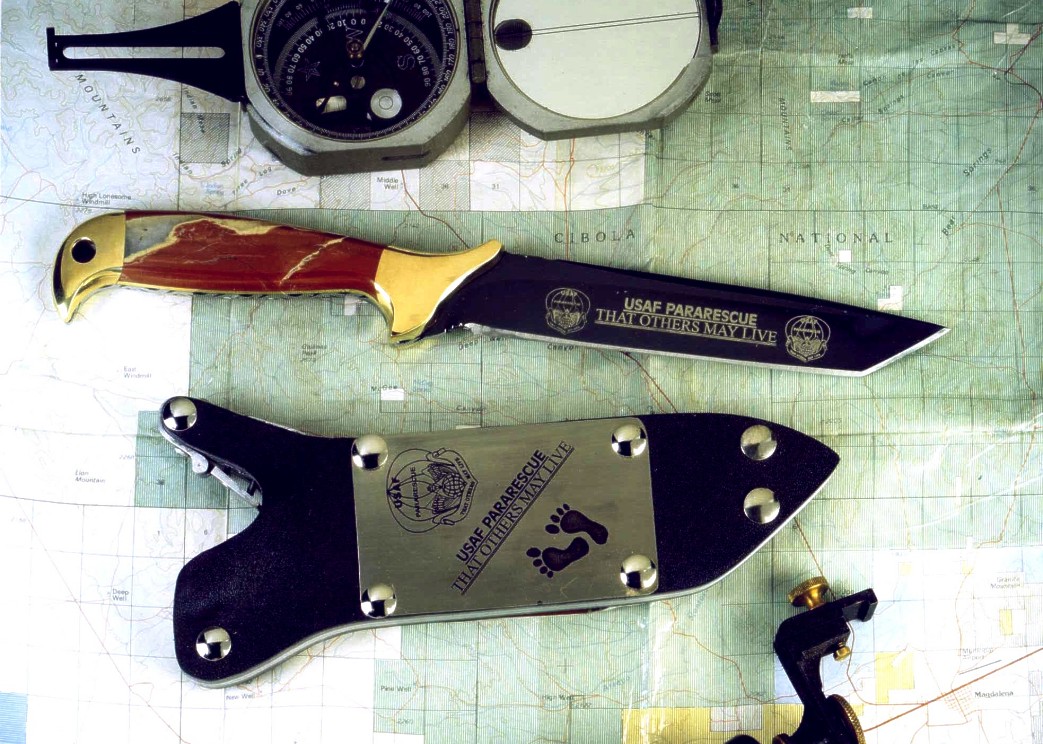Jay Fisher - Fine Custom Knives
New to the website? Start Here

"Cassiopeia"

On this page, you will read topics about my most popular tactical combat search and rescue knife, the PJLT (Pararescue Jumper LighT). There are captioned thumbnail photo boxes, and if there is an associated page to that photo with more information, photographs, and details, they will be linked in blue.
Thanks for being here and thanks for supporting our military, rescue, and law enforcement professionals who make it possible for us to love the life we live in the United States of America!
Jay,
This is Jared Lay; my family has bought several knives from you. I bought my brother, Jeremiah Lay, a PJLT
Shank knife for him when he graduated the fire academy. Well, long story short, my brother uses the knife
all the time and just had it with him in the Philippines, after the destruction. He went into some areas
for rescue that were the first rescue people in. Just wanted you to know we love the knives you have
made and that they are doing great work across the world.
--Jared Lay
Over a 25 years ago, a small group of men dressed in battle dress uniform rang the doorbell of my knife shop and studio in Magdalena, New Mexico. They told me they were conducting tactical training exercises twenty miles north of the village, in a remote part of the South Central New Mexico badlands. They were PJs.
PJ is the acronym for Pararescue Jumper, the short name version members of the United States Air Force Pararescue. This highly trained soldier-paramedic-rescue service consists of some of the finest men in our military, indeed some of the finest men in our country. They expend incredible amounts of training, endurance, education, practice, and trials to become the guys who go behind enemy lines to rescue other men. USAF Pararescue is, simply, our best and finest military combat rescue service.
PJs are also asked to perform rescues in civilian emergency crisis situations. When civilian rescues are more than civilians can handle, and are where civilian rescue services can't go, USAF Pararescue will be there, answering the call. They do this so that others may live.
When this elite group of men asked if I could make some knives, some very special knives, I was deeply honored to give them my best. They worked with me to design their dream knives that they would use and carry in the field. It started with a small group of knives: the Paraeagle, the Creature, the SERE Kid, and the large PJ as the initial knives designed by active duty Pararescuemen for their use in combat and rescue. Of these four, the PJ was created to be a large and imposing tanto-bladed weapon and tool, with substantial size and meat for heavy use. Though the large-sized PJ was and still is a very popular knife design with military, rescue service, professionals, and collectors, I took it upon myself to design a smaller, lighter version, that was easier to carry, yet had some of the same great features, components, and geometry of the larger knife. From these earlier designs, I created the PJ LighT, or PJLT.
As soon as I finished the first PJLT, I knew I had a hit. This was a substantial knife, toughly designed with just the right geometry and balance to be extremely useful, reliable, and a worthwhile adjunct to the rescue service skill, while retaining the characteristics to be a viable and formidable weapon when needed. With the addition of some useful features like my vampire rip-teeth serrations and top length spine swages, the PJLT has proven itself in the field of combat, service, and rescue across the wide range of tactical and rescue service. While being Pararescue's most popular knife, it has also become a favorite of SWAT team members, Emergency Response Units, Law Enforcement, and even Hazardous Materials professionals.
With the history, design, and reputation of the PJLT, it is not surprising that it is my most popular knife overall. I make more PJLTs than any other knife in my pattern inventory of over 400 patterns.
The PJLT is clearly a fine knife, originally designed for CSAR and utility use, a knife that has become a necessity for many well-equipped professionals, valued by collectors, and depended on by knife users and enthusiasts.

"My sheath held my knife in place at all times... On one mission when
rappelling into a hot HLZ with a 70 lbs pack I went upside down and got
drug when the Helo decided to spilt, my knife was there.
Jay, I know of no other knife that you made that have seen so much action. From the
first ever Jump mission conducted at the PJ School to the 2 OEF
deployments 23 Combat missions in all; not to forget multiple peace
time missions. When my life depends on my knife why carry anything but
the very best. Thanks for building the best for the best."
--SZ (Super), USAF Pararescue
The PJLT was originally designed as a light Pararescue CSAR (Combat Search and Rescue) knife with tactical combat applications. It has found favor across many fields, from civilian rescue organizations, firefighters, SERE (Survival, Evasion, Resistance, and Escape) specialists, law enforcement and SWAT (Special Weapons and Tactics) teams, combat infantrymen and even professional smokejumpers. I've made this knife for a wide range of specialists and knife enthusiasts, and even made several in collector's grade, materials, embellishment, and finish.
The main directive of the PJLT is and always will be United States Air Force Pararescue, and the knife has even found favor with the instructors at the PJ school at Kirtland Air Force Base in Albuquerque, New Mexico. I'm honored to make these knives.
Some of the best knife stories I've heard come from the owners of this knife. One was used to rescue a Navy SEAL from a wrecked APC, one was used to pry the skin off a damaged HELO. One was used to save a trapped PJ's life by severing a nasty cargo net from a tossing tanker in the middle of the ocean. One was used in a critical rescue effort of a collapsed building, and several others have been used to defend a life in CQC (Close Quarters Combat). Others are at the ready, strapped to a PJ, during jumps in combat and over the ocean.
I can't go where these knives do, but I'm thrilled to know they are there!
Thanks Jay.
We all really appreciated that you took time
out of your day, as busy as you are, to let us come by and
check everything out. It was very impressive to see all the
work, skill and care that goes into the knives you produce.
I also wanted to express thanks for being so supportive
toward what were trying to do, and more so, the military in
general. We all thought that was really nice. I'm really
excited about this knife, just the plastic cut out today was
neat, I cant wait to see the finished product.
Once again thanks,
--N.F., USAF Pararescue
Jay,
Just wanted to drop you a quick line. I picked up the knife from fed ex last night
and everything is there. Your work is superb! This thing is very light and fast in
the hand I cant wait to get it into action. Some people think I am crazy for spending
so much on a blade, but in the end knives are worth every penny! Especially if you
carry one as your back up weapon and your primary cutting tool into an environment
where it must work. Thanks again for your superb work again! Great job!
Vic, US Navy
Since the PJLT is custom and handmade, it can be made in any size, with any materials, finish, embellishment, and personalization that the client desires. On this page, you'll see many different types of PJLT, and I'll add more as they are made. Some useful options and accessories should be considered for optimization of a custom knife.
Since making the PJLT is a custom affair, and since it is my most popular knife, you'll see many variations of the PJLT on my site and some are featured below. Some are artistic adaptations, some are derivatives of the original PJLT design, adapted for Pararescue and professional use. This is a versatile knife design, and I look forward to experiencing the evolution of the PJLT in my future years. Please check back as I continually update the website. Thanks most for supporting our military, rescue, and law enforcement professionals who make it possible for us to love the life we live in the United States of America!


| Main | Purchase | Tactical | Specific Types | Technical | More |
| Home Page | Where's My Knife, Jay? | Current Tactical Knives for Sale | The Awe of the Blade | Knife Patterns | My Photography |
| Website Overview | Current Knives for Sale | Tactical, Combat Knife Portal | Museum Pieces | Knife Pattern Alphabetic List | Photographic Services |
| My Mission | Current Tactical Knives for Sale | All Tactical, Combat Knives | Investment, Collector's Knives | Copyright and Knives | Photographic Images |
| The Finest Knives and You | Current Chef's Knives for Sale | Counterterrorism Knives | Daggers | Knife Anatomy | |
| Featured Knives: Page One | Pre-Order Knives in Progress | Professional, Military Commemoratives | Swords | Custom Knives | |
| Featured Knives: Page Two | USAF Pararescue Knives | Folding Knives | Modern Knifemaking Technology | My Writing | |
| Featured Knives: Page Three | My Knife Prices | USAF Pararescue "PJ- Light" | Chef's Knives | Factory vs. Handmade Knives | First Novel |
| Featured Knives: Older/Early | How To Order | Khukris: Combat, Survival, Art | Food Safety, Kitchen, Chef's Knives | Six Distinctions of Fine Knives | Second Novel |
| Email Jay Fisher | Purchase Finished Knives | Serrations | Hunting Knives | Knife Styles | Knife Book |
| Contact, Locate Jay Fisher | Order Custom Knives | Grip Styles, Hand Sizing | Working Knives | Jay's Internet Stats | |
| FAQs | Knife Sales Policy | Concealed Carry and Knives | Khukris | The 3000th Term | Videos |
| Current, Recent Works, Events | Bank Transfers | Military Knife Care | Skeletonized Knives | Best Knife Information and Learning About Knives | |
| Client's News and Info | Custom Knife Design Fee | The Best Combat Locking Sheath | Serrations | Cities of the Knife | Links |
| Who Is Jay Fisher? | Delivery Times | Knife Sheaths | Knife Maker's Marks | ||
| Testimonials, Letters and Emails | My Shipping Method | Knife Stands and Cases | How to Care for Custom Knives | Site Table of Contents | |
| Top 22 Reasons to Buy | Business of Knifemaking | Tactical Knife Sheath Accessories | Handles, Bolsters, Guards | Knife Making Instruction | |
| My Knifemaking History | Professional Knife Consultant | Loops, Plates, Straps | Knife Handles: Gemstone | Larger Monitors and Knife Photos | |
| What I Do And Don't Do | Belt Loop Extenders-UBLX, EXBLX | Gemstone Alphabetic List | New Materials | ||
| CD ROM Archive | Independent Lamp Accessory-LIMA | Knife Handles: Woods | Knife Shop/Studio, Page 1 | ||
| Publications, Publicity | Universal Main Lamp Holder-HULA | Knife Handles: Horn, Bone, Ivory | Knife Shop/Studio, Page 2 | ||
| My Curriculum Vitae | Sternum Harness | Knife Handles: Manmade Materials | |||
| Funny Letters and Emails, Pg. 1 | Blades and Steels | Sharpeners, Lanyards | Knife Embellishment | ||
| Funny Letters and Emails, Pg. 2 | Blades | Bags, Cases, Duffles, Gear | |||
| Funny Letters and Emails, Pg. 3 | Knife Blade Testing | Modular Sheath Systems | |||
| Funny Letters and Emails, Pg. 4 | 440C: A Love/Hate Affair | PSD Principle Security Detail Sheaths | |||
| Funny Letters and Emails, Pg. 5 | ATS-34: Chrome/Moly Tough | ||||
| Funny Letters and Emails, Pg. 6 | D2: Wear Resistance King | ||||
| Funny Letters and Emails, Pg. 7 | O1: Oil Hardened Blued Beauty | ||||
| The Curious Case of the "Sandia" |
Elasticity, Stiffness, Stress, and Strain in Knife Blades |
||||
| The Sword, the Veil, the Legend |
Heat Treating and Cryogenic Processing of Knife Blade Steels |